Pacific Coast Models 1/32 Hurricane I (early)
|
KIT #: |
48020 |
|
PRICE: |
$69.95 MSRP |
|
DECALS: |
Six options |
|
REVIEWER: |
Tom Cleaver |
|
NOTES: |
|

The Hawker Hurricane was the first modern monoplane fighter to equip the
RAF, and was one of only three RAF aircraft to operate in first-line service
from the first day of the Second World War to the last.
Though the Spitfire gained the glory in the
Battle
of
Britain,
it was the tough Hurricane that won the fight.
Three-fifths of the squadrons of RAF's Fighter Command were mounted on
Sidney Camm's fighter that summer of 1940.
Though outperformed by the
Bf-109E, the Hurricane had the benefit of being “primitive” enough in its
construction that shot-down Hurricanes could be quickly repaired and returned to
service, which was the RAF “secret” that really won the Battle of Britain; fully
60 percent of the Hurricanes shot down over England that summer were repaired
and returned to operational use during the battle - a fact that Goering's
Luftwaffe missed as they confidently predicted that on September 15, 1940, there
would be no RAF fighters over London.
It was a scandal when reports came out that production Hurricane I's
could barely make 305 mph at 10,000 feet - the height at which most combat
occurred - and that the airplane could not be flown over 20,000 feet, the
altitude from which the Messerschmitts dove out of the sun on their targets.
Outclassed or not, the Hurricane I was there when it was needed, in
numbers sufficient to change the outcome of a battle nearly everyone expected
Britain
to lose. As such, it is a model
deserving of a place of distinction in any collection.
1 Squadron in
the “Phoney War” and the
Battle
of
France:
 Immediately following the declaration of war by
Britain
and
France,
the British government decided to send an aerial force alongside the troops and
armor of the British Expeditionary Force (BEF).
The French government demanded the British supply ten squadrons, but Air
Chief Marshal Sir Hugh Dowding, commander of Fighter Command, would not allow
the Spitfire to be send out of the country. Initially, two fighter squadrons ‑ 1
Squadron and 73 Squadron - which had been among the first RAF units to equip
with the Hurricane on its entry into service in 1937-38 - were sent to protect
the Fairey Battles and Bristol Blenheims that comprised the bombing units of the
Advanced Air Striking Force (AASF), while 85 and 87 Squadrons provided fighter
cover for the BEF closer to the Channel.
1 Squadron moved to Le Havre on September 8, and to Cherbourg on
September 10, flying on to their base at Vassincourt on September 15, while 73
Squadron flew to Caen on September 10 and then on to Rouvres on the 12th.
By October 1, the AASF had deployed both its fighters and bombers around
Reims
in support of the French Army in the Maginot Line.
The pilots of 1 Squadron were billeted in Neuville, a village with only
modest amusements; thus the pilots of 1 Squadron frequently visited their
colleagues in 73 Squadron at Rouvres, or sought out the nightlife of
Metz,
Nancy
or Bar‑le‑Duc.
Immediately following the declaration of war by
Britain
and
France,
the British government decided to send an aerial force alongside the troops and
armor of the British Expeditionary Force (BEF).
The French government demanded the British supply ten squadrons, but Air
Chief Marshal Sir Hugh Dowding, commander of Fighter Command, would not allow
the Spitfire to be send out of the country. Initially, two fighter squadrons ‑ 1
Squadron and 73 Squadron - which had been among the first RAF units to equip
with the Hurricane on its entry into service in 1937-38 - were sent to protect
the Fairey Battles and Bristol Blenheims that comprised the bombing units of the
Advanced Air Striking Force (AASF), while 85 and 87 Squadrons provided fighter
cover for the BEF closer to the Channel.
1 Squadron moved to Le Havre on September 8, and to Cherbourg on
September 10, flying on to their base at Vassincourt on September 15, while 73
Squadron flew to Caen on September 10 and then on to Rouvres on the 12th.
By October 1, the AASF had deployed both its fighters and bombers around
Reims
in support of the French Army in the Maginot Line.
The pilots of 1 Squadron were billeted in Neuville, a village with only
modest amusements; thus the pilots of 1 Squadron frequently visited their
colleagues in 73 Squadron at Rouvres, or sought out the nightlife of
Metz,
Nancy
or Bar‑le‑Duc.
Among the pilots of 1 Squadron was Pilot Officer Peter W.O. “Boy” Mould,
who had joined the RAF as a Boy Entrant in 1933. A great athlete, he was
selected for a cadetship at the
RAF
College,
Cranwell, where he became a Triple Blue at rugby, cricket and athletics.
While on patrol over the lines on
October 30, 1939,
Mould spotted a Dornier Do-17 of 2 Staffel/ Fernaufklärungsgruppe 123,
which he surprised so completely that in his after-action report he stated that
the Dornier “appeared to have been taken by surprise as no evasive tactics were
employed and no fire was encountered.” Mould’s victory was the first RAF victory
against a German aircraft over the Continent in the Second World War. In the
tradition of the Royal Flying Corps, the squadron took souvenirs from the crash
site near Toul, and celebrated the victory in style. Mould, sobered on seeing
the wreckage, confessed to Paul Richey (later the author of the classic,
“Fighter Pilot”) that he was “...bloody sorry I went and looked at the wreck.
What gets me down is the thought that I did it.”
On
November 1, 1939,
73 Squadron scored their first victory, when Flying Officer E.J. “Cobber” Kain
shot down another Dornier. By the
end of the year, the two squadrons had shot down a total of 20 German aircraft.
Enemy activity increased along the Western Front in the latter part of
November 1939, with 1 and 73 Squadrons claiming 5 Do-17s, and one He-111. In
January, 1940, 1 Squadron began receiving metal-wing Hurricanes with the Merlin
III,
which used the new deHavilland variable-pitch propeller, and the early
Hurricanes were completely replaced by March.
The winter of 1939‑40 was one of the worst winters in the previous 100
years, with heavy snow covering the airstrips of northern
France
and preventing flying for weeks at a time.
No one on the Allied side knew that this heavy winter had prolonged what
came to be known as “the Phoney War,” since the Wehrmacht was unable to mount
the winter offensive they had planned to launch in late November, following the
defeat of Poland. Spring arrived slowly; by March 1940, the weather had improved
sufficiently to allow the RAF squadrons to return to an intensive schedule of
defensive patrols.
On
March 29, 1940,
“Johnny” Walker, Bill Stratton, and “Taffy” Clowes of 1 Squadron downed the
first Bf-110 lost by the Luftwaffe over the Western Front when they
encountered a section of three Bf-110s. In the ensuing fight, all three
were shot down without loss. Later
that day, Paul Riche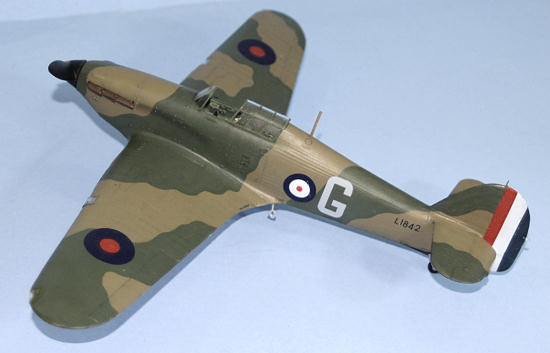 y
shot down the squadron’s first Bf-109E. By April 20th, 1 squadron had
claimed 23 German aircraft shot down for the loss of five Hurricanes, and one
pilot killed.
y
shot down the squadron’s first Bf-109E. By April 20th, 1 squadron had
claimed 23 German aircraft shot down for the loss of five Hurricanes, and one
pilot killed.
The “Phoney War” came to an abrupt end on
May 10, 1940,
when the great German offensive in the west, the blitzkrieg, began.
German paratroopers landed in
Holland
and
Belgium
as German tank columns and infantry surged across the frontiers of these neutral
countries to go around the Maginot line in a reprise of the Schlieffen Plan of
World War I. The French northern
armies and the British Expeditionary Force moved forward into
Belgium
to block these moves.
At dawn that day, 300 German bombers launched coordinated attacks on 22
Allied airfields in
Holland,
Belgium,
and northeast
France.
The German offensive prompted the French government to appeal to Winston
Churchill - who had assumed the position of Prime Minister only that morning -
for reinforcements. Given a direct
order by the Prime Minister, the reluctant Dowding was forced to send 3 and 79
Squadrons to
France.
On May 12, eight Hurricanes of 1 Squadron escorted five Battles of 12
squadron in an attack on the two bridges spanning the
Albert
Canal.
The Hurricanes ran into a swarm of Bf-109s; in the ensuing dogfight they
claimed four Bf-109s and two Henschel Hs-126 spotters.
However, all five Battles were lost to fighters or flak, without
achieving their objective. Posthumous
Victoria
Crosses were awarded to Flying Officer Garland and Sergeant Gray for pushing
home their attack, which did destroy a bridge span.
By May 13th, 1 Squadron had claimed 40 victories for the loss of nine
Hurricanes. That same day the squadron’s top-scorer Leslie Clisby and his
wingman Lawrie Lorimer were both killed in a fight with Bf-110s. Clisby died not
knowing he had just been awarded a
DFC
for destroying nine German aircraft.
On May 14, the Allies realized the Germans had added something unexpected
to the Schlieffen Plan when an armored force led by General Erwin Rommel broke
out of the supposedly impassable
Ardennes
Forest,
heading towards
Sedan
and threatening to flank the troops in the Maginot Line.
French General Gaston‑Henri Billotte ordered an air attack on the bridges
over the
Meuse
in a desperate effort to stem the German tide. The AASF, under the command of
Air Vice‑Marshal P.H.L. Playfair, sent its bombers to the attack with the
understanding that the Battles and Blenheims would receive fighter escort from
L’Armeé de L’Air. The attack was a disaster, with the Luftwaffe
and German flak shooting down 21 French fighters and 48 RAF bombers ‑ nearly
half the AASF’s strength.
Holland
surrendered on May 15. French Prime
Minister Paul Reynaud telephoned Churchill to inform him “we have been defeated.
We are beaten. We have lost the
battle.” Churchill flew to Paris the next day, to find French government
officials were burning records.
When he asked General Gamelin where the strategic reserve that might be deployed
to save
Paris
was stationed, the General replied: “there is none.” Churchill later described
this as the single most shocking moment of his life.
1 Squadron continued flying against the Luftwaffe until May 19th
when the pilots left
France
for
England.
The unit had claimed 86
victories between May 10-19, with the loss of 17 Hurricanes and two pilots
killed, and two seriously wounded.
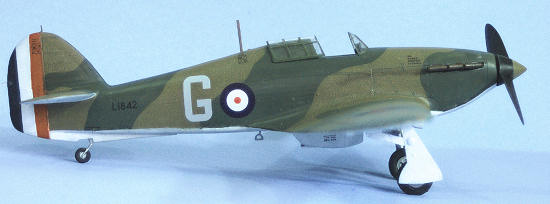 On May 25, British General Lord Gort ordered the withdrawal of the BEF
from
Arras
towards
Dunkirk.
The legendary evacuation began two days later. Between May 27th
and June 4th, the Royal Navy evacuated 338,226 British, French,
Belgian, and Dutch troops to south‑east
England.
On May 25, British General Lord Gort ordered the withdrawal of the BEF
from
Arras
towards
Dunkirk.
The legendary evacuation began two days later. Between May 27th
and June 4th, the Royal Navy evacuated 338,226 British, French,
Belgian, and Dutch troops to south‑east
England.
Spitfires finally joined the Hurricanes in defending the evacuation.
The RAF’s role was little appreciated by the soldiers waiting on the
exposed beaches of
Dunkirk.
Cloud obscured sight of RAF fighters, but not the scream of the diving Stukas;
the strategy of trying to intercept the Luftwaffe away from the beaches,
while largely successful, left many survivors of the BEF believing the RAF had
abandoned them to the mercy of German air attack.
The re-formed 1 Squadron returned to
France
in the first week of June, moving frequently from field to field before arriving
at Boos, on the
Seine,
on June 14th to cover further British evacuations.
On June 17th, the squadron flew into
Brittany
to cover the evacuation of
Cherbourg
before returning to
Britain,
with the ground crews embarking at
La Rochelle
for return to
England.
During the five weeks of the
Battle
of
France,
1 Squadron claimed 125 victories for the loss of 22 aircraft, three pilots
killed, and two severely wounded. By the end of June, ten Distinguished Flying
Crosses had been awarded to officers of the squadron, and three Distinguished
Flying Medals to NCO pilots.
The Wehrmacht entered
Paris
on June 14th, and the French government capitulated on June 25th.
During the
Battle
of
France,
the Armeé de L’Air lost 1,274 aircraft to the Luftwaffe, which
lost 1,428 aircraft in the campaign. Out of 452 fighters the RAF sent to
France,
only 66 returned to
Britain,
with 208 lost in combat, while 178 were abandoned by ground crews as
unserviceable.
Among the notable pilots of 1 Squadron during the Battle of France were
Pilot Officer Billy Drake, who would end the war as the most successful of all
this group, being promoted to Wing Commander and claiming 28 aircraft shot down,
plus 15 more destroyed on the ground, and awarded the DSO,
DFC
and Bar, and a US
DFC;
he remained in the RAF postwar, to become a Group Captain.
The squadron’s top-scorer during the
Battle
of
France
was Flying Officer L.R. Clisby, an Australian who had claimed at least ten
aircraft shot down, and possibly more, by the time he was shot down and killed
on May 14. Flying Officer Paul H.M.
Richey, who claimed 10 victories during the
Battle
of
France
before being wounded on May 19, became the author of “Fighter Pilot,” one of the
classic books of the war; he returned to operations in 1941, and ended the war
as a Wing Commander. Canadian
Flying Officer M.H. “Hilly” Brown claimed 17 victories by the time the squadron
left France in June; he was promoted to command the squadron soon after their
return to England, and led the unit during the Battle of Britain, after which he
was promoted to Wing Commander in 1941 and posted to Malta, where he was shot
down and killed over Sicily on November 12, 1941.
The outstanding NCO pilot was Flight Sergeant F.J. Soper, who claimed 13
victories over France and was later commissioned; as a Squadron Leader in 1941,
he failed to return from a sortie to intercept an intruding German bomber off
the Suffolk coast on October 5, 1941.
Having claimed the squadron’s first aerial victory, Peter Mould scored
six more victories during the
Battle
of
France
in May and June 1940, and two more during the
Battle
of
Britain.
Promoted to Squadron Leader, he was killed in action over
Malta
on October 1, 1941.
This early Hurricane Mk. I by Pacific Coast Hobbies (molded by Sword,
photo-etch from Eduard and decals by Cartograf, designed by Richard Caruana) is
the second “rag-wing” Hurricane released in injection plastic, the other being
the 1/48 Hurricane by Classic Airframes that is now long out of production.
The only other 1/32 Hurricane I in injection plastic is the ancient
Revell offering from circa the early 1970s.
In the initial release, it was offered as an 8-gun metal-wing Mark I,
though the kit was later changed with a wing for the 4 20mm cannon of a Mk. IIc,
without further modification of the fuselage to Mk.II standard.
The kit has been recently re-released by Revell of
Germany.
The only advantage this kit has is that it is a
Battle
of
Britain
metal wing airplane, but in fact
Pacific
Coast
Models will be releasing a metal wing airplane at some point on the
not-too-distant future.
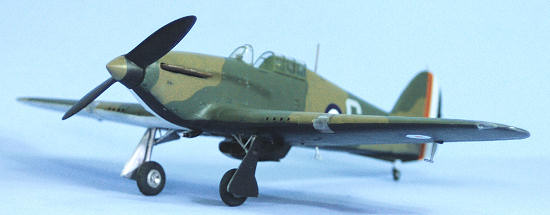 The kit features some of the best surface detail for a fabric-covered
airplane I have yet seen; other manufacturers should look at this when designing
their own releases of fabric airplanes, particularly for World War I models.
Both the early “kidney” and later ejector exhausts are provided, as well
as the two-blade
Watts
prop, and the deHavilland and Rotol 3-blade controllable-pitch props, along with
two different styles of main wheels with 4 and 5-spoke hubs.
You should be careful in deciding which of these items to use with which
airplane you are doing, because things changed rapidly during the period
covered. For instance, the boxart
option is shown with a 3-blade prop - which is correct per photos of this
airplane - though the instructions would have you do it with the 2-blade prop.
The cockpit gives about as much detail as one finds in the 1/48 Hasegawa kit,
which is more than enough since the Hurricane had a very simple cockpit.
The instrument panel is a photo-etch “sandwich,” and the Sutton harness
is also provided in photo-etch.
The kit features some of the best surface detail for a fabric-covered
airplane I have yet seen; other manufacturers should look at this when designing
their own releases of fabric airplanes, particularly for World War I models.
Both the early “kidney” and later ejector exhausts are provided, as well
as the two-blade
Watts
prop, and the deHavilland and Rotol 3-blade controllable-pitch props, along with
two different styles of main wheels with 4 and 5-spoke hubs.
You should be careful in deciding which of these items to use with which
airplane you are doing, because things changed rapidly during the period
covered. For instance, the boxart
option is shown with a 3-blade prop - which is correct per photos of this
airplane - though the instructions would have you do it with the 2-blade prop.
The cockpit gives about as much detail as one finds in the 1/48 Hasegawa kit,
which is more than enough since the Hurricane had a very simple cockpit.
The instrument panel is a photo-etch “sandwich,” and the Sutton harness
is also provided in photo-etch.
The excellent Cartograf decals include markings for no fewer than six
different airplanes, including one each from the Belgian and Finnish Air Forces
and an ex-Yugoslav Hurricane that was test-flown by the Regia Aeronautica.
All three RAF aircraft are from the period from the
Munich
Crisis in September 1938 to just before the end of the
Battle
of
France
in May 1940.
The parts option for the armored windscreen has a serious molding flaw in
it that I have not been able to correct in two different attempts.
Fortunately the Finnish, Belgian, and one of the RAF options are for
Hurricanes without the armored windscreen.
I think one could fake this using the unarmored windscreen and attaching
a piece of clear plastic sheet cut to shape.
Ken Lawrence of Pacific Coast Models has already stated that this problem
will be solved in their future release, which will have the armored windscreen
as its only option.
Looking at the parts breakdown, there is only going to be a metal-wing
Mark I, since the fuselage parts do not have a separate cowling.
Since the lower rear fuselage is molded separately, one might expect the
possibility of a Sea Hurricane.
Overall, this model is not difficult if one has some experience of
limited-run kits. However, there is
a “big secret” to overall assembly which can have a major effect on the way your
model turns out.
The kit instructions and a modeler’s experience would have one build the
kit as two major sub-assemblies - the fuselage and the wing - and then mate them
once otherwise assembled. DO NOT
DO THIS! From my experience of
now having built two of these kits, if you follow the “common knowledge,” you
will end up with a huge gap on the upper wing joints, with the wing upper
surface not conforming to the curvature of the fuselage joint, which will
require a lot of filling and sanding, with the result that you will lose a whole
lot of very nice surface detail in that area that you do not want to replace
since you can’t do it as well as it was done originally.
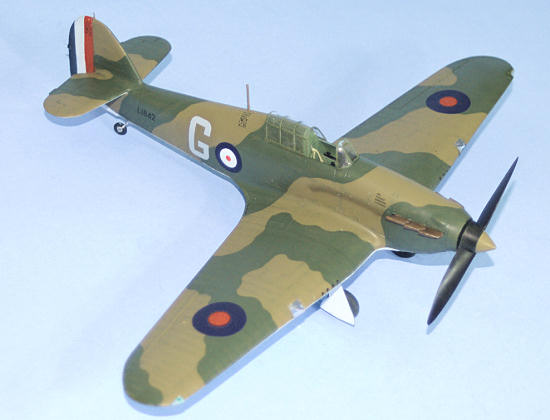 Here’s the trick to doing this kit with a minimum of hassle and a maximum
of good looks when finished: You have to approach the model as a collective
whole. There are not two major
sub-assemblies to this project, but rather one overall process.
Here’s the trick to doing this kit with a minimum of hassle and a maximum
of good looks when finished: You have to approach the model as a collective
whole. There are not two major
sub-assemblies to this project, but rather one overall process.
The first thing to do is to assemble the fuselage, including the lower
rear part. While that is setting
up, assemble and paint the cockpit and install the seat belts. I strongly urge
that you attach the rear cockpit headrest bulkhead and the instrument panel into
the fuselage separately. Once you
have the rest of the cockpit assembled, slip it inside and glue it in position.
At this point, you need to test fit the canopy if you plan to pose it
open, and to sand down the area of the fuselage immediately aft of the cockpit
so the canopy can sit down properly.
Once the fuselage is done, you want to attach the upper wing parts.
You will immediately notice that the curvature of the upper wing differs
from that of the fuselage joint.
You’re going to need to engage in a bit of industrial-strength bending and
curling to get the upper wing to fit - don’t be afraid to stress the plastic, it
is soft enough it won’t crack or break. Once everything fits nice and tight,
work the joint from inside, to lessen the amount of glue that is used on the
exterior. If you trim and get it
just right, you should need only a very little bit of Mr. Surfacer along the
upper wing joint to get it smooth, which means you won’t be losing any of that
wonderful surface detail.
When you cut the molding block off the main gear well, be sure to dremel
down the roof of the well to where you can see light through the outer areas on
each end, and then round down the piece fore and aft on the top.
Assemble the interior parts for the gear well and attach it to the lower
wing.
You then need to test fit the lower wing to the rest of the model. Trim
as necessary to get a nice smooth fit to the fuselage fore and aft.
Then take the leading edge gun port for one wing, test fit it to the
upper wing, trimming the cutout in the wing as necessary to get good fit, then
glue it in position. Test fit the
lower wing, and trim that cutout as necessary to get good fit.
Do the same on the other wing.
Then fit the lower wing and be sure the cutouts for the landing lights
are aligned. Glue the landing light
parts into the upper wing, then glue the lower wing in position.
If you have done this right, you will only need a little Mr. Surfacer
along the joints to the fuselage, and a little sanding down of the wingtips so
they match up.
All that might sound like a lot of work, but it is really very minor
fiddling, and the end result of not having harmed all the wonderful surface
detail is well worth all the effort taken.
The joint of the horizontal stabilizers to the fuselage will need a
little filling with cyanoacrylate glue and then some Mr. Surfacer.
The lower fuselage strake will need a little filling with cyanoacrylate
when you attach it.
Past that, all you need to do is sand down the joints and do some light
rescribing.
As regards the landing gear, assemble the three-part gear doors before
attaching them to the gear legs, to insure proper fit.
For all the Hurricanes presented here, you will want to use the 4-spoke
wheels.
Painting:
While I was doing my research, I found a profile of the Hurricane flown
by Peter Mould on
October 30, 1939,
done by Caruana in the Modeler’s Datafile for the Hawker Hurricane.
I did some digging in the decal dungeon and found the numbers for the
serial, and with two Hurricane kits I had the correct number of Type A roundels
to do that airplane.
First, I painted the gear wells, landing gear and gear door interiors
with Tamiya “Flat Aluminum. Then I
painted the lower right side of the model and the rudder with Tamiya “Flat
White.” I then masked off the lower
surface, and the center stripe of the r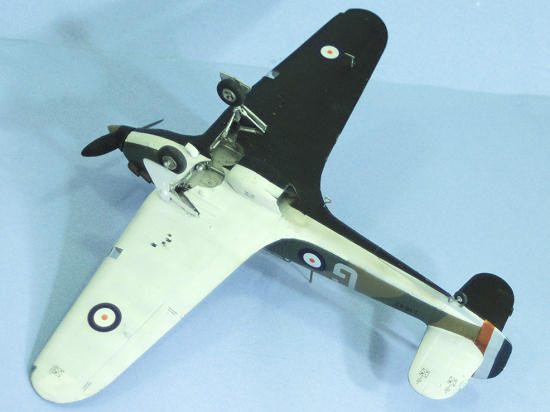 udder.
I mixed some Gunze-Sangyo “Red 23" and “Red Madder” to get a color that
matched the brick red of the decals and painted the forward stripe. I then mixed
some Tamiya “Semi-Gloss Black” with Tamiya “Flat Blue” to match the blue color
of the decals, and shot the rear stripe.
I then masked off the rudder.
I painted the lower left half of the underside with Tamiya “Semi-Gloss
Black” and then masked that.
udder.
I mixed some Gunze-Sangyo “Red 23" and “Red Madder” to get a color that
matched the brick red of the decals and painted the forward stripe. I then mixed
some Tamiya “Semi-Gloss Black” with Tamiya “Flat Blue” to match the blue color
of the decals, and shot the rear stripe.
I then masked off the rudder.
I painted the lower left half of the underside with Tamiya “Semi-Gloss
Black” and then masked that.
The upper surfaces were done in an “A” scheme camouflage (at that time,
Hurricanes with even-numbered serials were in the A scheme, with odd-number
serials in the B scheme that mirrored the A scheme), using Xtracrylix “RAF Dark
Earth” and “RAF Dark Green,” which are the most accurate paints of these colors.
Since Xtracrylix will dry the same shade whether applied with a brush or
an airbrush, I thinned some “RAF Dark Green” after I had applied the “RAF Dark
Earth” and painted the outlines of the disruptive green pattern.
I then airbrushed the pattern and had “hard” edges that didn’t require
masking - now you have another good reason to use Xtracrylix.
When everything was dry, I unmasked the model and gave it two coats of
Xtracrylix Gloss Varnish.
Decals:
Other than using some letters and numbers from the decal dungeon for the
serials, I used kit decals for everything else.
This airplane had the small 9 inch serials, so using the standard 1/48
letters and numbers for 12-in serials gave me what I needed.
The two squadrons in the Advanced Air Striking Force were different from
all others in that they had roundels on the lower wing surfaces.
I used the Type A roundels from the second Hurricane kit for these.
I also had to modify the identity letter “G” with a longer upper stroke,
taking that from the “L” decal on the sheet.
The decals went down without a problem.
I do want to emphasize that there is absolutely nothing wrong with the
markings options that are provided in the kit.
On a personal level, I am surprised that Mould’s airplane wasn’t
provided, inasmuch as Richard Caruana had already done a profile for it in the
Modeler’s Datafile, and it certainly is a historically-important early
Hurricane. Had I not had the
numbers to do the serial, I would certainly have done one of the options
provided.
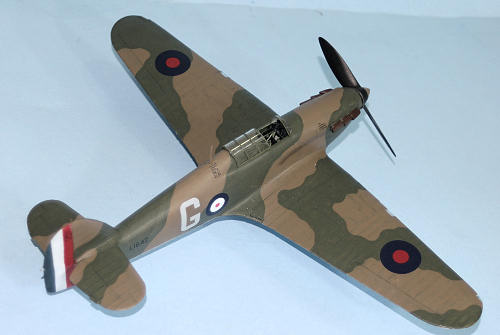 When you are doing one of these airplanes, you definitely need
photographs of the one you are doing, because while all the early Hurricanes
began life with the “kidney” exhausts, many were updated with the later ejector
exhaust, even while using the
Watts
propeller. While I didn’t have a
photo of Mould’s airplane, all the other photos I could find of 1 Squadron
Hurricanes with
Watts
propellers showed they used the later ejector exhausts, which I did here.
They also used the underwing pitot tube rather than the early venturi
tube. I also replaced the radio
antenna mast with one made from Evergreen strip.
The kit mast is not right for the early Hurricane, since that early mast
was un-tapered. I also used
Evergreen rod for the rudder mast.
When you are doing one of these airplanes, you definitely need
photographs of the one you are doing, because while all the early Hurricanes
began life with the “kidney” exhausts, many were updated with the later ejector
exhaust, even while using the
Watts
propeller. While I didn’t have a
photo of Mould’s airplane, all the other photos I could find of 1 Squadron
Hurricanes with
Watts
propellers showed they used the later ejector exhausts, which I did here.
They also used the underwing pitot tube rather than the early venturi
tube. I also replaced the radio
antenna mast with one made from Evergreen strip.
The kit mast is not right for the early Hurricane, since that early mast
was un-tapered. I also used
Evergreen rod for the rudder mast.
Assembling the landing gear presents no problems, though you need to
drill out the wheels a little deeper to take the entire axle.
With the gear doors assembled previously, there was no problem presented
in attaching them. I then attached
the navigation lights to the wing tips and the rudder.
I applied exhaust stains with Tamiya “Smoke.”
The canopy was posed in the open position and I attached the propeller.
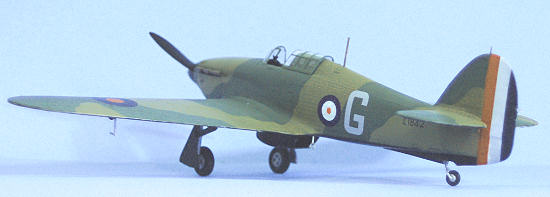 This is an excellent kit of the Hurricane.
While it is a limited-run kit and therefore requires some extra attention
in assembly, there is no problem presented that cannot be solved with a bit of
“some modeling skill required.” If
you assemble the model the way I did here, you will have few if any problems
during assembly, and the result will be a very good-looking model.
I have always thought the early “rag wing” Hurricane was interesting, and
am glad that PCM has started their line of Hurricanes with this version.
The model looks very good sitting next to my Hasegawa Spitfire I, and is
highly recommended.
This is an excellent kit of the Hurricane.
While it is a limited-run kit and therefore requires some extra attention
in assembly, there is no problem presented that cannot be solved with a bit of
“some modeling skill required.” If
you assemble the model the way I did here, you will have few if any problems
during assembly, and the result will be a very good-looking model.
I have always thought the early “rag wing” Hurricane was interesting, and
am glad that PCM has started their line of Hurricanes with this version.
The model looks very good sitting next to my Hasegawa Spitfire I, and is
highly recommended.
Review kit
courtesy of
Pacific
Coast
Models.
Tom Cleaver
February 2010
Copyright ModelingMadness.com. All rights reserved. No reproduction in part or in whole without express permission.
If you would like your product reviewed fairly and quickly, please
contact
the editor or see other details in the
Note to
Contributors.
Back to the Main Page
Back to the Review
Index Page 2023



 y
shot down the squadron’s first Bf-109E. By April 20th, 1 squadron had
claimed 23 German aircraft shot down for the loss of five Hurricanes, and one
pilot killed.
y
shot down the squadron’s first Bf-109E. By April 20th, 1 squadron had
claimed 23 German aircraft shot down for the loss of five Hurricanes, and one
pilot killed.


 udder.
I mixed some Gunze-Sangyo “Red 23" and “Red Madder” to get a color that
matched the brick red of the decals and painted the forward stripe. I then mixed
some Tamiya “Semi-Gloss Black” with Tamiya “Flat Blue” to match the blue color
of the decals, and shot the rear stripe.
I then masked off the rudder.
I painted the lower left half of the underside with Tamiya “Semi-Gloss
Black” and then masked that.
udder.
I mixed some Gunze-Sangyo “Red 23" and “Red Madder” to get a color that
matched the brick red of the decals and painted the forward stripe. I then mixed
some Tamiya “Semi-Gloss Black” with Tamiya “Flat Blue” to match the blue color
of the decals, and shot the rear stripe.
I then masked off the rudder.
I painted the lower left half of the underside with Tamiya “Semi-Gloss
Black” and then masked that.
